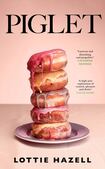
“He would tell her thirteen days before their wedding, and she would feel his words lodge like a shard of bone between her ribs.” There is nothing subtle about the hook in Lottie Hazell’s debut novel Piglet. The titular protagonist, from a working class family in Derby, is about to marry her wealthy boyfriend, Kit, and everything is going to plan – a very tightly wound, perfectly executed plan – until the end of the opening chapter when we get, in italics, the above warning. It’s a device that Hazell uses throughout her novel, which proves both frustrating and maddeningly effective.
On the one hand, these italicised passages at the end of each chapter don’t serve the story well. They disturb the flow of the narrative, highlighting that Hazell, as a debut writer, is perhaps yet to learn to trust her reader. But alongside Kit’s secret confession, they also work to give a propulsive quality to the narrative. Throughout the book, Hazell drip-feeds us information by having Piglet divulge the secret to other characters, such as her horrified best friend, Margot; troubled sister, Frannie; and unsupportive father, giving us access to their reactions, all the while spurring us on to turn the pages.
Comparisons to Meg Mason’s Sorrow and Bliss in the press material are overblown on a line level – the prose style of Piglet tends more towards commercial than literary – and likely pertain to the endings of both books, specifically the withholding of certain information. Difficult to discuss without spoilers, it’s fair to say that the mechanism felt more earned and organic in Sorrow and Bliss, which had a lot more driving the story than one big reveal. In Piglet the ending doesn’t deliver on a promise it has flaunted throughout, as if we’ve been led on for months and suddenly ghosted. This will undoubtedly, as the PR notes, provoke much discussion among readers.
At the heart of the novel is the question of satisfaction: what will it take, or how much will it take, for Piglet to be happy?
To give due credit to Hazell, that is no small feat for a debut author. A writer, contemporary literature scholar and board game designer, she holds a practice-based PhD from Loughborough University, where her research considered subversive femininity in 21st century fiction with a particular interest in the domestic, food writing and trauma narratives. She has previously worked in cookbook marketing, which she uses to fine effect in her fiction with evocative, unusual descriptions of food and dining.
At the heart of the novel is the question of satisfaction: what will it take, or how much will it take, for Piglet to be happy? With her nickname stemming from a long-running family joke on her ability to eat incredible amounts without ever feeling sated, it is clear that her obsession with food started early in life. Hazell explores how food can become a place holder for emotional problems long carried or buried. Some of the best scenes involve interactions with her parents, her thrifty father in particular, who seems unable to love without shame: “‘It’s just greed,’ he said, his eyes averted to the ceiling. ‘What is it about you and more, more, more?’”
The reader feels for Piglet in such instances, which is a good counterbalance to her other less relatable traits, including bridezilla myopia, self-pity and envy of the different life paths of her friends. But whether she is a “likeable” heroine doesn’t really matter. The thing that counts is whether she feels real. Hazell’s deft characterisation has enough light and shade to bring Piglet into high definition. The same is true for the side characters, which are commendably vivid for a debut.
In way that feels highly contemporary, the novel examines that old staple, appearance versus reality, through the prism of food
The trauma of weddings in difficult families – this supposedly blissful occasion where nothing negative can be aired – likewise feels very real, with the odd surreal flash as Piglet’s binge-eating goes out of control: “She stared at it, this appendage resting on the door. It was not a hoof, but it was not a hand.” The build-up to the wedding and the day itself are too long, an issue of a new writer still grappling with shape, but the fallout is enjoyable as Piglet decides to finally speak her feelings instead of eating them.
In way that feels highly contemporary, the novel examines that old staple, appearance versus reality, through the prism of food: “The menu was not modest. Her basket was already heavy with Charlotte potatoes, fresh herbs, and a Duchy chicken ... There would be salads. One chopped and scattered with feta and sumac, another leafy with soft herbs. New potatoes, boiled and dotted with a bright salsa verde. Bread and two types of butter: confit garlic, and parmesan and black pepper. There would be cold wine and open windows, patio doors thrown wide. It would all look and taste exquisite.” What it feels like for Piglet, however, is another matter entirely.















